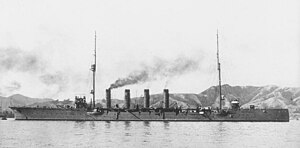Japanese cruiser Yahagi (1911)
 Yahagi in 1916
| |
| History | |
|---|---|
| Name | Yahagi |
| Namesake | Yahagi River |
| Ordered | 1907 Fiscal Year |
| Builder | Nagasaki |
| Laid down | 20 June 1910 |
| Launched | 3 October 1911 |
| Commissioned | 27 July 1912 |
| Stricken | 1 April 1940 |
| Fate | Scrapped, 1947 |
| General characteristics | |
| Class and type | Chikuma-class protected cruiser |
| Displacement | 5,040 long tons (5,121 t) |
| Length | 144.8 m (475 ft 1 in) o/a |
| Beam | 14.2 m (46 ft 7 in) |
| Draught | 5.1 m (16 ft 9 in) |
| Propulsion |
|
| Speed | 26 knots (30 mph; 48 km/h) |
| Range | 10,000 nmi (19,000 km) at 10 kn (12 mph; 19 km/h) |
| Complement | 414 |
| Armament |
|
| Armour |
|
Yahagi (矢矧) was the second vessel in the Chikuma class of protected cruisers of the Imperial Japanese Navy. Yahagi had two sister ships, Chikuma and Hirado. She was named after the Yahagi River, which runs through Nagano, Gifu and Aichi prefectures.
Background
The Chikuma-class light cruisers were built as part of the 1907 Naval Expansion Program, based on lessons learned during the
Design
Yahagi had a hull with an overall length of 144.8 metres (475 ft) and width of 14.2 metres (47 ft), with a normal displacement of 5040 tons and
Yahagi was propelled by two Parsons steam turbine engines, with a total capacity of 22,500 shp (16,800 kW), which drove two screws. The engine had 16 Kampon boilers, which exhausted though four tall smokestacks. These newly developed engines gave the ship an incredible (for the time) 27.14-knot (50.26 km/h; 31.23 mph) speed,[1] but problems with material strength in the gears of the new engines created a maintenance nightmare, and Yahagi could seldom live up to her potential.
The ship was armed with eight 15 cm/45 41st Year Type guns, one each fore and aft, and three mounted in sponsons on each side of the hull. Ships of the Chikuma class were unusual in having the same weapons for its side armament as for its main battery. These gun were supplemented by four QF 12-pounder 12 cwt naval guns and two 7.7 mm Lewis guns. In addition, she carried three torpedo launchers with 457 mm (18 in) torpedoes. After 1919, two 8 cm/40 3rd Year Type naval gun were added for anti-aircraft defense abeam of the fourth funnel, replacing three of the 12-pounders.[1]
Service record

Yahagi participated in
.From December 1914 to January 1915, Chikuma and Yahagi were assigned to patrols off the coast of northern Queensland, Australia.
On 7 February 1917 the Imperial Japanese Navy formed the First Special Squadron which composed the cruisers Yahagi,
Yahagi and Suma were ordered to the

The crew of Yahagi became stricken with influenza during the Great Influenza Epidemic of December 1918, and had to make an emergency port call at Manila harbor for 46 days, during which time 300 of her crew were incapacitated, and 48 died. A memorial at the burial site in 1938 still stands in Valenzuela still stands today.
After the end of the war, Yahagi was assigned to patrol off the coast of eastern
Afterwards, Yahagi was mostly assigned to guarding the southern approaches to Japan, and made frequent port calls to Manila and
After the start of the
Notes
References
- Evans, David C.; ISBN 0-87021-192-7.
- ISBN 0-87021-907-3.
- Jentschura, Hansgeorg; Jung, Dieter & Mickel, Peter (1977). Warships of the Imperial Japanese Navy, 1869–1945. Annapolis, Maryland: United States Naval Institute. ISBN 978-0-87021-893-4.
- Schencking, J. Charles (2005). Making Waves: Politics, Propaganda, And The Emergence Of The Imperial Japanese Navy, 1868-1922. Stanford University Press. ISBN 0-8047-4977-9.
- Tucker, Spencer C (2005). Encyclopedia of World War I: A Political, Social, And Military History. ABC-Clio Inc. ISBN 1-85109-420-2.
